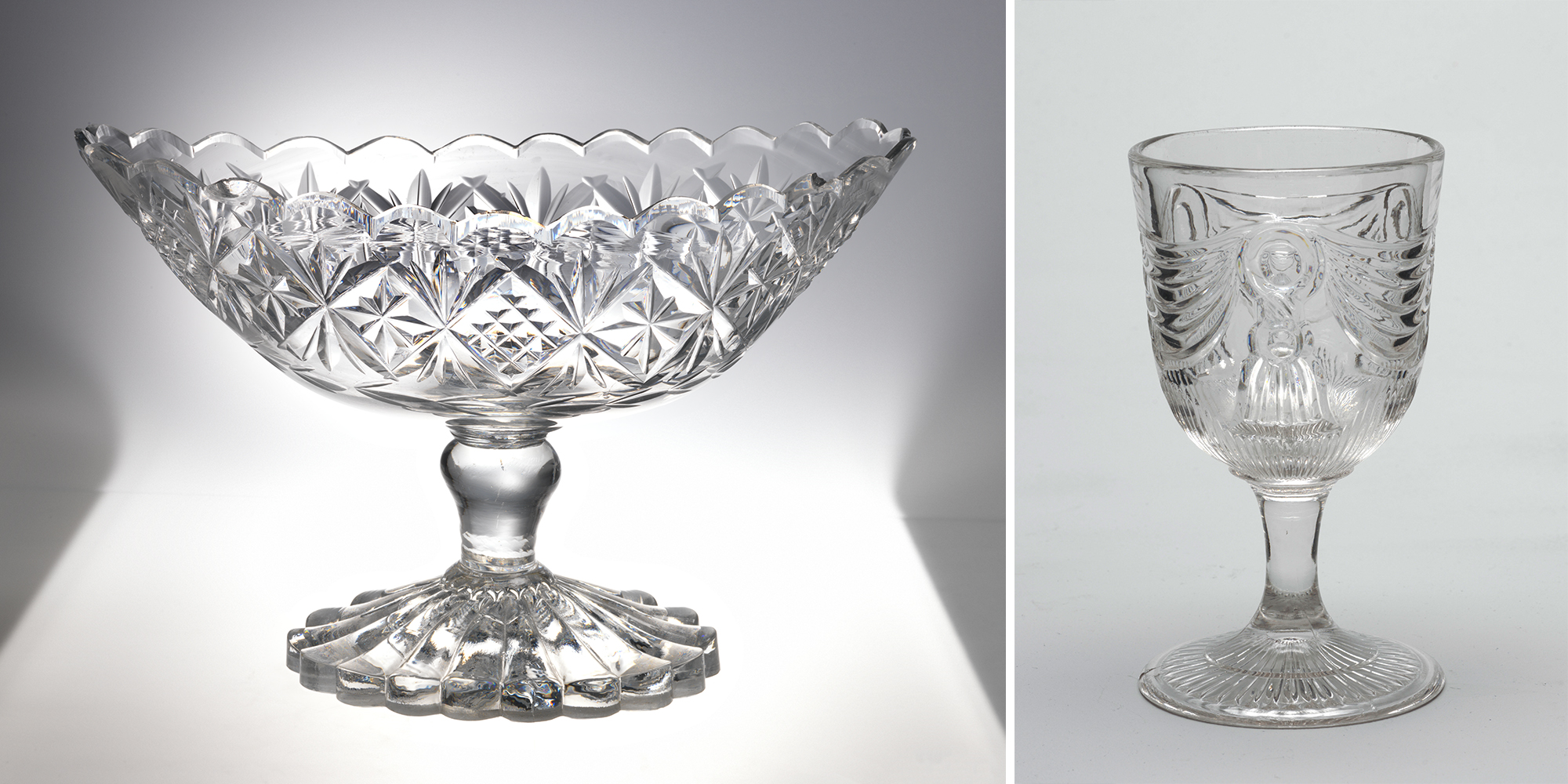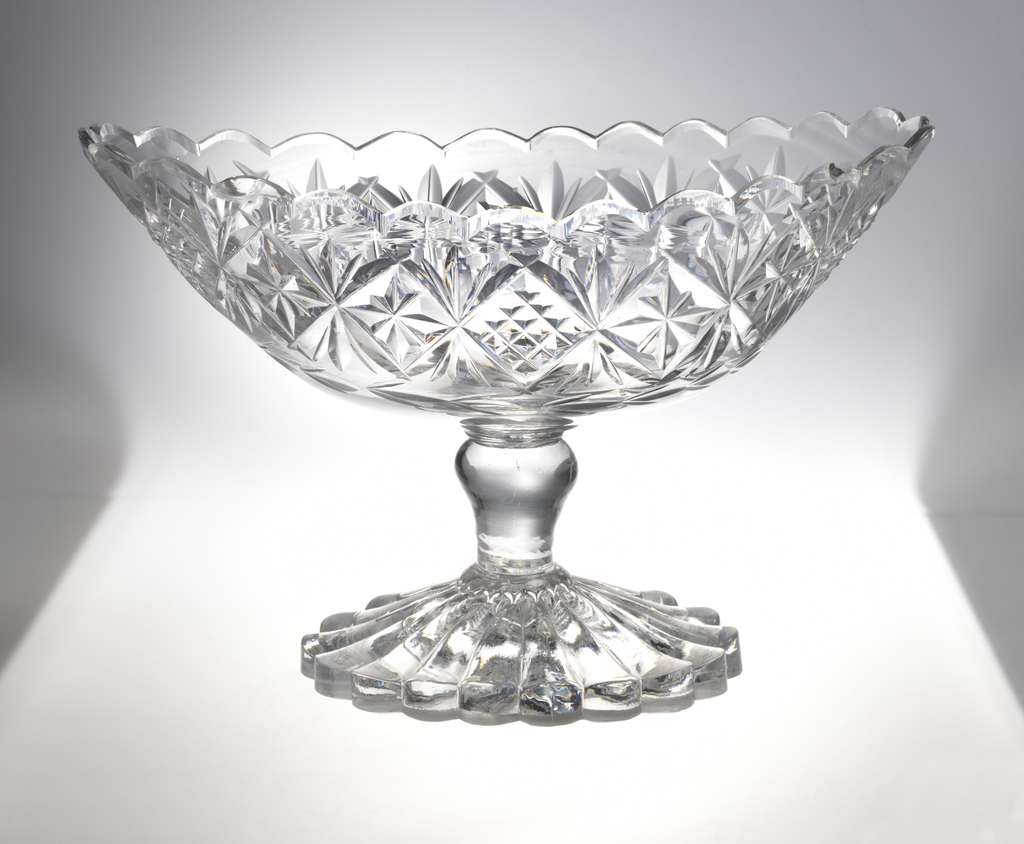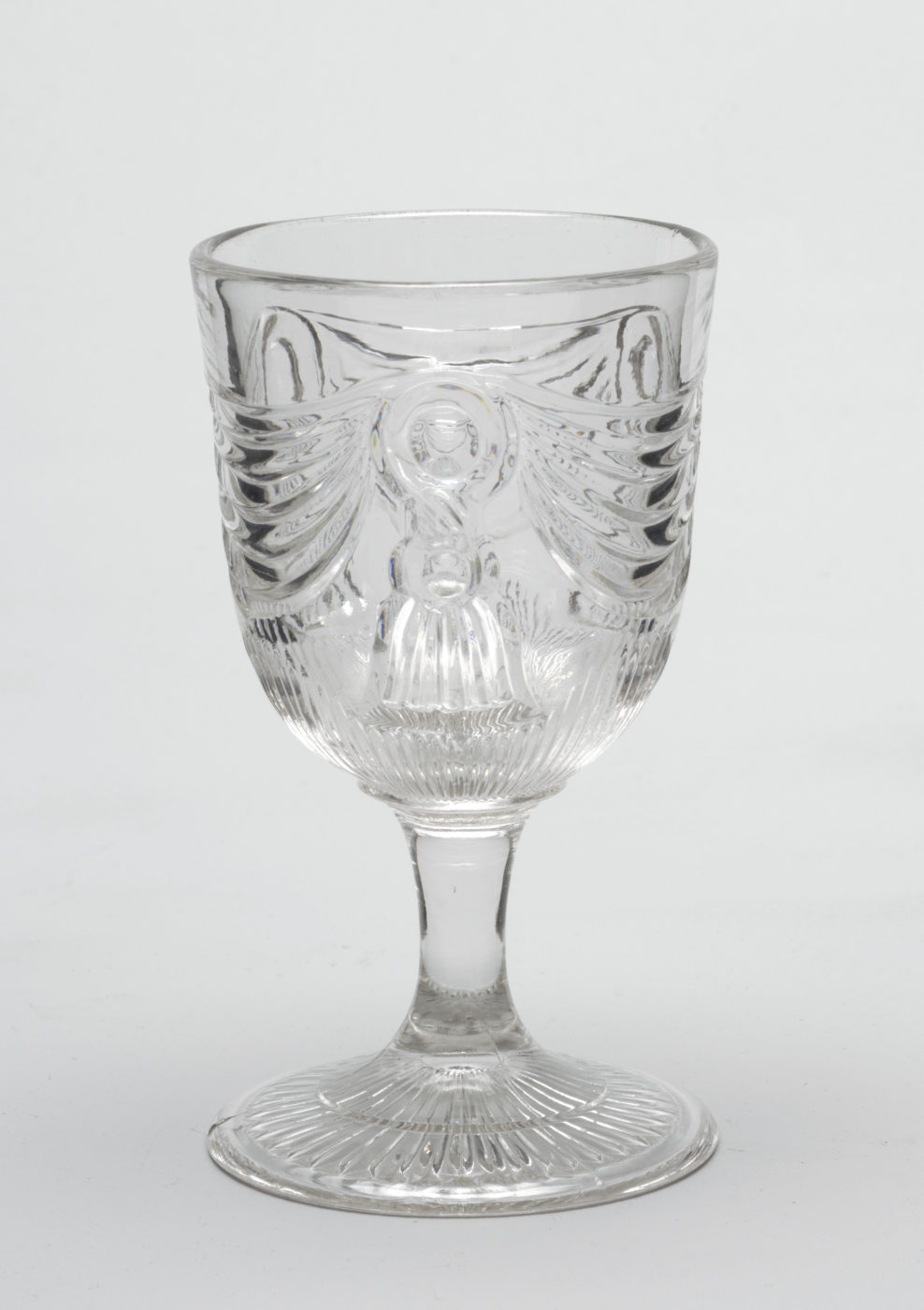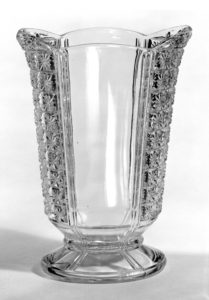Written by Jasmine Keegan
The United Nations has designated 2022 the International Year of Glass. Cooper Hewitt is celebrating the occasion with a yearlong series of posts focused on the medium of glass and museum conservation.

Left: Footed Bowl (Ireland), ca. 1810; Glass; H x W x D: 21.8 x 31.3 x 18cm (8 9/16 x 12 5/16 x 7 1/16in.); Bequest of Walter Phelps Warren, 1986-61-142. Right: Lincoln Drape Goblet (USA), mid-19th century; Glass; H x diam.: 15.5 × 9 cm (6 1/8 × 3 9/16 in.); Gift of Mrs. Granville Price, 1992-163-5.
This post focuses on two different technologies used to form and ornament glass tablewares: cut versus pressed glass. The goblet is made of pressed glass, while the bowl was cut to create its sparkling surface. Though both items are transparent and richly decorated, their manufacture and cost would have differed significantly. In the early 19th century, when the footed bowl was created, the cost and artistry required to manufacture such an ornate piece meant that it was not widely affordable. Skilled glass workers created the geometric surface through cutting the glass—a time intensive process. First, a glass maker blew the blank—the undecorated glass form. The piece was then transferred to an artisan who designed the pattern that was to be cut into the glass. The design was outlined before the piece was handed on to a rougher, who cut the glass with metal or stone rotating wheels coated with abrasive pastes to produce the desired pattern. Lastly, a polisher finished the piece, ensuring its brilliant shine.

Footed Bowl (Ireland), ca. 1810; Glass; H x W x D: 21.8 x 31.3 x 18cm (8 9/16 x 12 5/16 x 7 1/16in.); Bequest of Walter Phelps Warren, 1986-61-142
In contrast, the goblet was not cut but pressed into a mold to create the swag and tassel pattern, which became popularly known as the Lincoln Drape (the design, created following the death of President Abraham Lincoln, supposedly evoked the drapery that decorated his casket and hearse). The pressed technique was patented in the United States in 1826 and it truly revolutionized glass making. Pressed glass is produced by pouring molten glass into a mold and then using a machine to push, or press, the material into the form. Pieces made in this way are easily identifiable by the smooth interior surface of their vessels (since the mold only touches the outer glass surface) and chill marks, which are tiny ripples created when the hot glass is pressed into the cold metal mold. To try and mask chill marks in early pressed pieces, lacy pattern designs were often used to decorate the background. As this pressed technique grew in popularity, glass manufacturers developed new glass formulations to better align with the demands of the process.

Lincoln Drape Goblet (USA), mid-19th century; Glass; H x diam.: 15.5 × 9 cm (6 1/8 × 3 9/16 in.); Gift of Mrs. Granville Price, 1992-163-5
The efficiency with which pressed glass was manufactured impacted both the market for glasswares, as well as the types of food people consumed and how these foods were presented. For instance, salt cellars (small dishes for serving salt at the dining table) became increasingly popular, as did celery vases. Celery was highly prized at a wealthy Victorian family’s table. Ornate glassware remained a status symbol, but pressed glass provided a more affordable, accessible way to create a stylish household for a wider range of consumers. The glass industry in the United States flourished over the course of the later 19th century, reflecting manufacturing innovations that contributed greatly to the wider availability as well as the history of decorative functional glassware. As with other specialized production techniques, pressed glass is highly desired by collectors of historic glass.

Celery Vase, ca. 1880; Pressed glass; 18.4 x 8.3 x 18.1 cm (7 1/4 x 3 1/4 x 7 1/8 in.); Brooklyn Museum, Gift of Mrs. Cheever Porter, 57.90.42; Creative Commons-BY; Photo: Brooklyn Museum
Jasmine Keegan is a pre-program intern in conservation at Cooper Hewitt, having previously held internships at The Cleveland Museum of Art and the Whitney Museum of American Art. She graduated from Oberlin College in 2020 with a degree in art history.
3 thoughts on “Year of Glass: Cut vs. Pressed”
Larry kutzen on January 11, 2023 at 4:19 am
Pressed glass wasn’t produced until the 1850s The Lincoln drape was done in 1864.
Before pressed glass with soda lime glass was flint in the U.S. a few of the companies actually press molded flint and sosa lime glass into the same patterns in the 1850s and 60s. Flint was too heavy and expensive to get the general public. Manganese was used in the soda lime formula for clarity. That is what causes pressed glasses to turn purple when it has long exposure to the sun.
Charla Glimp on July 5, 2023 at 7:20 am
I have a collection of Spooner. I would like to sell them. Any advice
Carole Taylor on October 15, 2023 at 4:04 pm
I have pieces of cut glass. Would like to sell it.